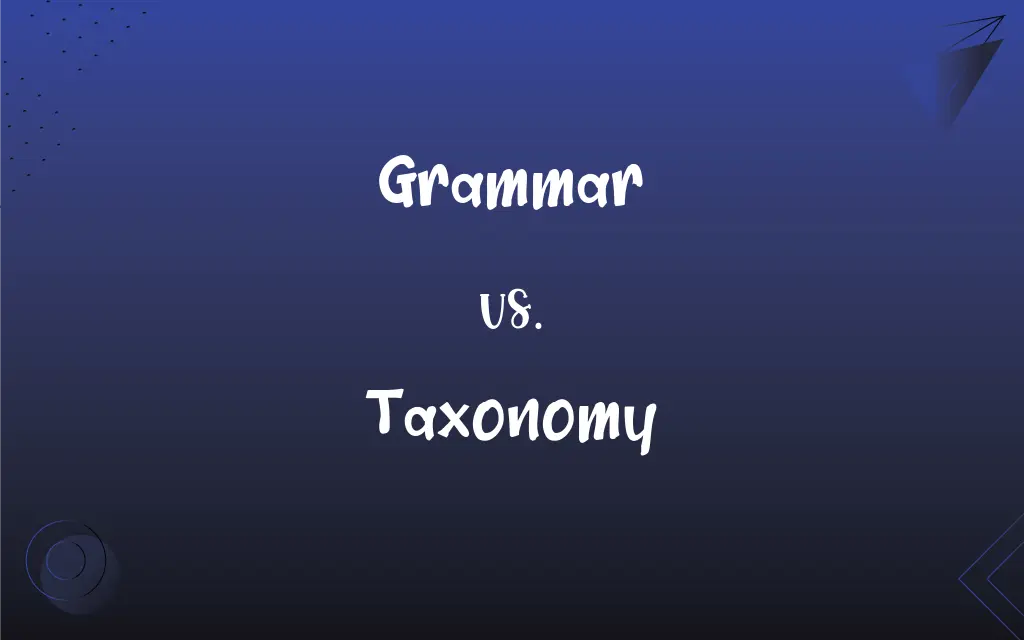Grammar vs. Taxonomy: What's the Difference?
Edited by Aimie Carlson || By Janet White || Updated on October 3, 2023
Grammar is the set of structural rules that govern the composition of words, phrases, and clauses in a language. Taxonomy is the practice of classifying and categorizing items or concepts, often in hierarchical structures.

Key Differences
Grammar is a set of rules and principles that govern the structure of sentences, words, and phrases in a particular language. It dictates how we form and interpret spoken and written language, from the arrangement of words to the use of punctuation. Taxonomy, on the other hand, is concerned with classifying and categorizing items or concepts based on common characteristics or relationships. While Grammar operates within the framework of a language, Taxonomy spans across multiple disciplines, from biology to information science.
Grammar is important for effective communication as it provides the groundwork for understanding and being understood in a specific language. It’s like a code that both the speaker and the listener must understand to communicate effectively. Taxonomy serves a different purpose; it helps us make sense of large data sets or complex systems by categorizing items or concepts into manageable groups. In other words, Taxonomy aids in organizing and finding information.
When it comes to Grammar, elements like syntax, morphology, and phonology come into play. Syntax focuses on sentence structure, morphology looks at word formation, and phonology deals with sound patterns. Taxonomy involves identifying, naming, and classifying items or concepts into hierarchical structures. For example, in biology, Taxonomy categorizes living organisms based on common characteristics, such as genus and species.
Both Grammar and Taxonomy offer frameworks for understanding complex structures, but they apply to different realms. Grammar is primarily concerned with the intricacies of language and communication, while Taxonomy deals more with classification and organization. Despite their different applications, both are essential tools for making sense of the complexities in their respective fields.
Comparison Chart
Focus
Language structure
Classification and categorization
ADVERTISEMENT
Application
Linguistics
Multiple disciplines
Elements
Syntax, Morphology, Phonology
Hierarchical structure
Purpose
Facilitate communication
Facilitate organization
Scope
Limited to languages
Cross-disciplinary
Grammar and Taxonomy Definitions
Grammar
Structure of language
The grammar rules help form coherent sentences.
ADVERTISEMENT
Taxonomy
Naming and categorizing
The taxonomy of animals includes various species and genera.
Grammar
Set of linguistic rules
Good grammar is crucial for effective communication.
Taxonomy
Subject categorization
The website uses taxonomy to sort articles.
Grammar
Syntax and morphology
Grammar involves the arrangement of words and their forms.
Taxonomy
Data organization
A good taxonomy helps in easier data retrieval.
Grammar
Rules for writing
Her grammar book covers punctuation and style.
Taxonomy
Hierarchical ordering
Taxonomy helps in organizing knowledge.
Grammar
Guide to communication
Learning grammar is essential for understanding a language.
Taxonomy
The classification and naming of organisms in an ordered system that is intended to indicate natural relationships, especially evolutionary relationships.
Grammar
The study of how words and their component parts combine to form sentences.
Taxonomy
The science, laws, or principles of classification.
Grammar
The study of structural relationships in language or in a language, sometimes including pronunciation, meaning, and linguistic history.
Taxonomy
An ordered arrangement of groups or categories
A taxonomy of literary genres.
Grammar
The system of inflections, syntax, and word formation of a language.
Taxonomy
The science or the technique used to make a classification.
Grammar
The system of rules implicit in a language, viewed as a mechanism for generating all sentences possible in that language.
Taxonomy
A classification; especially, a classification in a hierarchical system.
Grammar
A normative or prescriptive set of rules setting forth the current standard of usage for pedagogical or reference purposes.
Taxonomy
The science of finding, describing, classifying and naming organisms.
Grammar
Writing or speech judged with regard to such a set of rules.
Taxonomy
That division of the natural sciences which treats of the classification of animals and plants, primarily by consideration of their natural relationships with respect to their structure or genetic origin; the laws or principles of classification; systematics.
Grammar
A book containing the morphologic, syntactic, and semantic rules for a specific language.
Taxonomy
A systematic arrangement of objects or concepts showing the relations between them, especially one including a hierarchical arrangement of types in which categories of objects are classified as subtypes of more abstract categories, starting from one or a small number of top categories, and descending to more specific types through an arbitrary number of levels. An ontology usually contains a taxonomy as one of the important principles of organization.
Grammar
The basic principles of an area of knowledge
The grammar of music.
Taxonomy
A classification of organisms into groups based on similarities of structure or origin etc
Grammar
A book dealing with such principles.
Taxonomy
(biology) study of the general principles of scientific classification
Grammar
A system of rules and principles for speaking and writing a language.
Taxonomy
Practice of classifying plants and animals according to their presumed natural relationships
Grammar
The study of the internal structure of words (morphology) and the use of words in the construction of phrases and sentences (syntax).
Taxonomy
System of classification
The taxonomy of plants is complex.
Grammar
A book describing the rules of grammar of a language.
Grammar
(computing theory) A formal system specifying the syntax of a language.
Grammar
Actual or presumed prescriptive notions about the correct use of a language.
Grammar
(computing theory) A formal system defining a formal language
Grammar
The basic rules or principles of a field of knowledge or a particular skill.
Grammar
A book describing these rules or principles; a textbook.
A grammar of geography
Grammar
(UK) A grammar school.
Grammar
To discourse according to the rules of grammar; to use grammar.
Grammar
The science which treats of the principles of language; the study of forms of speech, and their relations to one another; the art concerned with the right use and application of the rules of a language, in speaking or writing.
Grammar
The art of speaking or writing with correctness or according to established usage; speech considered with regard to the rules of a grammar.
The original bad grammar and bad spelling.
Grammar
A treatise on the principles of language; a book containing the principles and rules for correctness in speaking or writing.
Grammar
Treatise on the elements or principles of any science; as, a grammar of geography.
When any town shall increase to the number of a hundredfamilies or householders, they shall set up a grammar school, the master thereof being able to instruct youth so far as they may be fitted for the University.
Grammar
To discourse according to the rules of grammar; to use grammar.
Grammar
Studies of the formation of basic linguistic units
FAQs
Is Grammar just about punctuation?
No, grammar encompasses more, including syntax, word formation, and sentence structure.
Does Grammar change over time?
Yes, grammar rules can evolve with language use.
What does Taxonomy classify?
Taxonomy classifies various things, from living organisms to data, based on common characteristics.
Is Grammar the same in all languages?
No, each language has its own set of grammar rules.
Can Taxonomy apply to digital information?
Yes, taxonomy can be used to categorize and organize digital data.
Do all English speakers use the same Grammar?
Generally, but there can be variations based on dialects and usage.
What's the goal of Taxonomy?
The main goal is to categorize and organize items or concepts for easier understanding or retrieval.
Is Grammar always formal?
No, colloquial speech often employs informal grammar.
How is Grammar taught?
Grammar is usually taught through formal education, books, and practice.
Can poor Grammar affect communication?
Yes, poor grammar can lead to misunderstandings or unclear messages.
Can Taxonomy be subjective?
While it aims for objectivity, some level of subjectivity can occur in taxonomy.
Can Grammar include spoken rules?
Yes, grammar rules also apply to spoken language, not just written.
Is Taxonomy restricted to biology?
No, taxonomy is used in various disciplines, including information science and psychology.
How is Taxonomy created?
Taxonomy is often created by experts through observation, research, and analysis.
Is Taxonomy always hierarchical?
Often, but not always. Some taxonomies are flat or networked.
About Author
Written by
Janet WhiteJanet White has been an esteemed writer and blogger for Difference Wiki. Holding a Master's degree in Science and Medical Journalism from the prestigious Boston University, she has consistently demonstrated her expertise and passion for her field. When she's not immersed in her work, Janet relishes her time exercising, delving into a good book, and cherishing moments with friends and family.
Edited by
Aimie CarlsonAimie Carlson, holding a master's degree in English literature, is a fervent English language enthusiast. She lends her writing talents to Difference Wiki, a prominent website that specializes in comparisons, offering readers insightful analyses that both captivate and inform.































































